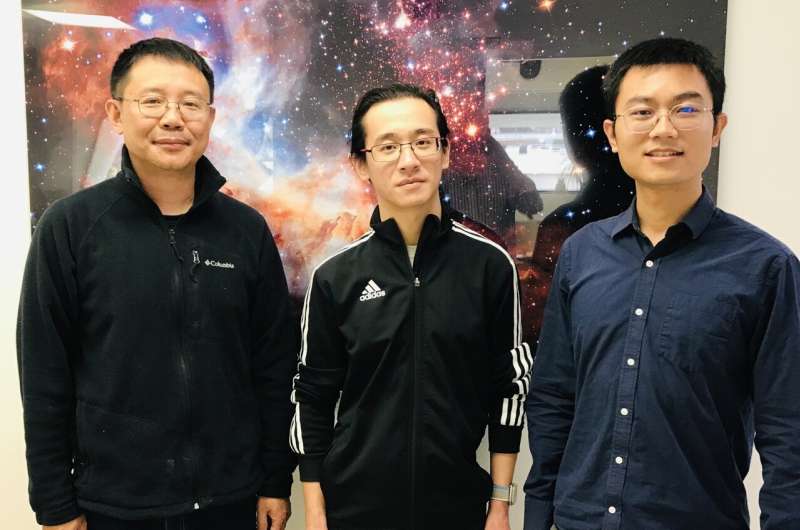
Photo shows from L to R: Hai-Bo Yu, Demao Kong, and Daneng Yang. Credit: Hai-Bo Yu, UC Riverside.
Last September, the James Webb Space Telescope, or JWST, discovered JWST-ER1g, a massive ancient galaxy that formed when the universe was just a quarter of its current age. Surprisingly, an Einstein ring is associated with this galaxy. That’s because JWST-ER1g acts as a lens and bends light from a distant source, which then appears as a ring—a phenomenon called strong gravitational lensing, predicted in Einstein’s theory of general relativity.
The total mass enclosed within the ring has two components: stellar and dark matter components.
“If we subtract the stellar mass from the total mass, we get the dark matter mass within the ring,” said Hai-Bo Yu, a professor of physics and astronomy at the University of California, Riverside, whose team has published new work about JWST-ER1g in the journal The Astrophysical Journal Letters. “But the value for the dark matter mass seems higher than expected. This is puzzling. In our paper, we offer an explanation.”
A dark matter halo is the halo of invisible matter that permeates and surrounds a galaxy like JWST-ER1g. Although dark matter has never been detected in laboratories, physicists are confident dark matter, which makes up 85% of the universe’s matter, exists.
“When ordinary matter—pristine gas and stars—collapses and condenses into the dark matter halo of JWST-ER1g, it may be compressing the halo, leading to a high density,” said Demao Kong, a second-year graduate student at UCR, who led the analysis. “Our numerical studies show that this mechanism can explain the high dark matter density of JWST-ER1g—more dark matter mass in the same volume, resulting in higher density.”
According to Daneng Yang, a postdoctoral researcher at UCR and co-author on the paper, JWST-ER1g, formed 3.4 billion years after the Big Bang, provides “a great chance to learn about dark matter.”
“This strong lensing object is unique because it has a perfect Einstein ring, from which we can obtain valuable information about the total mass within the ring, a critical step for testing dark matter properties,” he said.
Launched on Christmas Day in 2021, NASA’s JWST is an orbiting infrared observatory. Also called Webb, it is designed to answer questions about the universe. It is the largest, most complex, and most powerful space telescope ever built.
“JWST provides an unprecedented opportunity for us to observe ancient galaxies formed when the universe was young,” Yu said. “We expect to see more surprises from JWST and learn more about dark matter soon.”
The study was supported by the John Templeton Foundation and the U.S. Department of Energy.
The title of the open access research paper is “Cold Dark Matter and Self-interacting Dark Matter Interpretations of the Strong Gravitational Lensing Object JWST-ER1.”
More information:
Demao Kong et al, Cold Dark Matter and Self-interacting Dark Matter Interpretations of the Strong Gravitational Lensing Object JWST-ER1, The Astrophysical Journal Letters (2024). DOI: 10.3847/2041-8213/ad394b
Citation:
Physicists solve puzzle about ancient galaxy found by Webb telescope (2024, April 13)
retrieved 14 April 2024
from https://phys.org/news/2024-04-physicists-puzzle-ancient-galaxy-webb.html
This document is subject to copyright. Apart from any fair dealing for the purpose of private study or research, no
part may be reproduced without the written permission. The content is provided for information purposes only.
>>> Read full article>>>
Copyright for syndicated content belongs to the linked Source : Phys.org – https://phys.org/news/2024-04-physicists-puzzle-ancient-galaxy-webb.html
